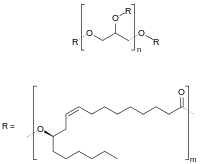Polyglycerol polyricinoleate
 | |
| Names | |
|---|---|
| IUPAC name
1,2,3-Propanetriol, homopolymer, (9Z,12R)-12-hydroxy-9-octadecenoate | |
| Identifiers | |
| 29894-35-7 [1] | |
| ChemSpider | |
| PubChem | 9843407 |
| Properties | |
| (C3H5O2)n(C18H32O2)m | |
| Related compounds | |
| Related compounds |
Triricinolein (monomer)
polyglycerol ricinoleic acid |
| Except where noted otherwise, data is given for materials in their standard state (at 25 °C (77 °F), 100 kPa) | |
| | |
| Infobox references | |
Polyglycerol polyricinoleate (PGPR), E476, is an emulsifier made in a three-step process[2] from glycerol and fatty acids (usually castor bean derived). PGPR reduces the viscosity of chocolate and similar coatings and compounds. It works by decreasing the friction between the particles of cacao, sugar, milk, etc. present so they can flow more easily when melted. It is used at low levels (below 1%). It is made up of a short chain of glycerol molecules connected by ether bonds, with ricinoleic acid side chains connected by ester bonds.
PGPR is a yellowish, viscous liquid composed of polyglycerol esters of polycondensed fatty acids from castor oil. It may also be polyglycerol esters of dimerized fatty acids of soybean oil.
PGPR is strongly lipophilic, soluble in fats and oils, and insoluble in water and ethyl alcohol. In chocolates, it is used as a viscosity-reducing agent.[3] It is virtually always paired with lecithin or another plastic viscosity-reducing agent.
It can also be used as an emulsifier in spreads and in salad dressings or as a crystal inhibitor and anticlouding agent in fractionated vegetable oils.
In a 1998 study funded by Unilever, "PGPR was found to be 98% digested by rats and utilized as a source of energy superior to starch and nearly equivalent to groundnut oil."[4] Additionally, no evidence was found of interference with normal fat metabolism, nor with growth, reproduction, and maintenance of tissue. Overall, it did not "constitute a human health hazard."[5]
Manufacture
Glycerol is heated to above 200°C in a reactor in the presence of an alkaline catalyst to create polyglycerol. Castor oil fatty acids are separately heated to above 200°C, to create interesterified ricinoleic fatty acids. The polyglycerol and the interesterified ricinoleic fatty acids are then mixed to create PGPR.[6]
Use in chocolate candy bars
PGPR is used by chocolate makers to reduce their costs of raw materials. Since 2006, commercial-grade candy bars, such as those made by Hersheys and Nestlé, made an industry-wide switch to include PGPR as an ingredient - a possible indicator of a cost-saving measure by the commercial chocolate industry. Makers of PGPR such as Danisco and Palsgaard indicate PGPR can be used to replace the traditional but more expensive cocoa butter as an ingredient in chocolate. Palsgaard's website asserts, "Cocoa butter is an expensive raw material for chocolate manufacturers. By using PALSGAARD 4150 the chocolate recipe has lower costs in terms of less cocoa butter but also gives the benefit of having less fat."[7]
However, the 1996 study conducted by Andrew Waterhouse of UC Davis which discovered the phenols (potent antioxidants) in chocolate also revealed that these antioxidants come from cocoa butter and the stearic acid it produces. It demonstrated that the phenols prevented LDL cholesterol from building up in arteries. Another study had subjects follow diets in which the majority of fat calories came from either chocolate or butter; only those with the butterfat diet showed an increase in LDL cholesterol. [8]
See also
References
- ↑ "GRAS Notice 000270: polyricinoleic acid" (PDF). Retrieved 2011-10-25.
- ↑ http://www.accessdata.fda.gov/scripts/fcn/gras_notices/grn000266.pdf
- ↑ "Kind of Emulsifiers". Riken Vitamin.
- ↑ The Wilson R, Van Schie BJ, Howes D. (Sep–Oct 1998). "Overview of the preparation, use and biological studies on polyglycerol polyricinoleate (PGPR)" study was paid for by Unilever a significant manufacturer of PGPR and holder of European Patent Application EP2086351 Kind Code: A1 for "Title: EDIBLE EMULSIONS WITH PGPR" http://www.freepatentsonline.com/EP2086351.html
- ↑ Wilson R, Van Schie BJ, Howes D. (Sep–Oct 1998). "Overview of the preparation, use and biological studies on polyglycerol polyricinoleate (PGPR)". Food Chem Toxicol 36 (9-10): 711–718. doi:10.1016/S0278-6915(98)00057-X. PMID 9737417.
- ↑ http://www.fda.gov/ucm/groups/fdagov-public/@fdagov-foods-gen/documents/document/ucm269157.pdf
- ↑ "High grade PGPR in chocolate". Palsgaard.
- ↑ http://news.ucdavis.edu/search/news_detail.lasso?id=3390